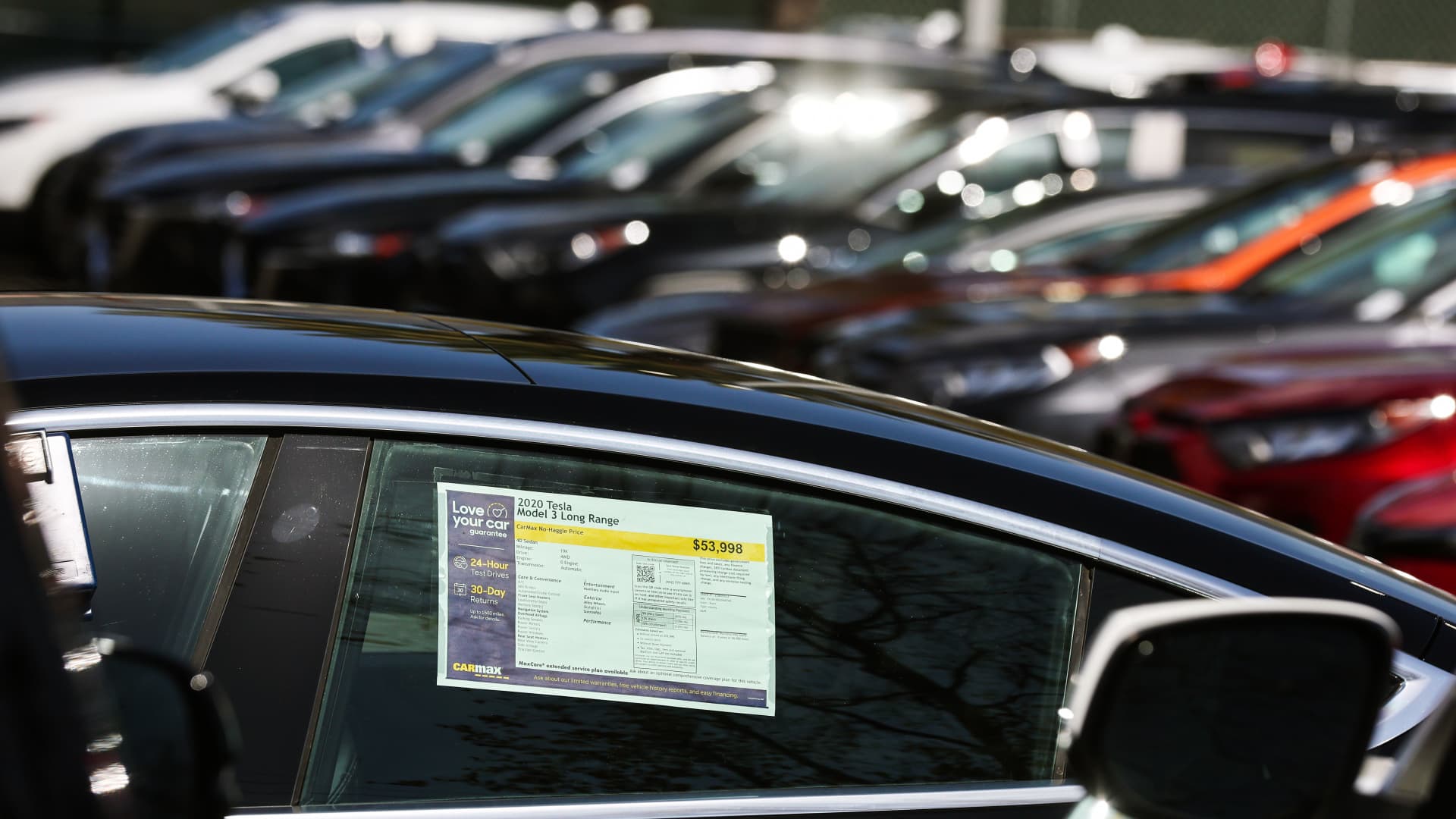Used EV price crash gets deeper with ‘premium’ brand idea history
[ad_1]
A used 2020 Tesla Model 3 is available for sale on a CarMax lot on March 10, 2022 in Burbank, California.
Mario Tama | Getty Images News | Getty Images
Back in February, used electric vehicle prices dipped below used gasoline-powered vehicle prices for the first time ever, and the pricing cliff keeps getting steeper as car buyers reject any “premium” tag formerly associated with EVs.
The decline has been dramatic over the past year. In June 2023, average used EV prices were over 25% higher than used gas car prices, but by May, used EVs were on average 8% lower than the average price for a used gasoline-powered car in U.S. In dollar terms, the gap widened from $265 in February to $2,657 in May, according to an analysis of 2.2 million one to five year-old used cars conducted by iSeeCars. Over the past year, gasoline-powered used vehicle prices have declined between 3-7%, while electric vehicle prices have decreased 30-39%.
“It’s clear used car shoppers will no longer pay a premium for electric vehicles,” iSeeCars executive analyst Karl Brauer stated in an iSeeCars report published last week. Electric power is now a detractor in the consumer’s mind, with EVs “less desirable” and therefore less valuable than traditional cars, he said.
The gap between used luxury brands and EVs has widened, too. Used BMW prices exceed prices for comparable, all-electric, Tesla vehicles by a significant amount, according to iSeeCars. A Tesla Model 3 cost $2,635 more than a BMW 3 Series in May 2023, but by May of this year, was priced over $4,800 less than the 3 Series.
More people are selling their used EVs today than ever before, at least partially because the market is bigger than every before. In 2022, 176,918 used EVs were purchased in the U.S. In May alone, that number increased to over 45,000. There are many more vehicles in the used market than new car market, and used vehicle value does rapidly depreciate as a rule. A one-year-old used car is, on average, priced at 80% of the same car sold new. As more EVs enter the used market at lower prices, the EV market does become available to a wider market of potential first-time EV owners.
There are reasons why EV premiums are more likely to decline in the used market regardless of the recent consumer perception shift: battery technology is continually getting better, increasing range on new models, and consumers also worry about batteries degrading over time. Newer models have longer ranges and improved battery life with temperature control for charging. Between 30-50% of the value embedded in an EV is the battery. But offsetting that is the fact that EVs have lower overall owner costs, from fuel to maintenance, and owners of used EVs can qualify for federal tax credits.
A key factor in the recent decline in used EV prices has been Tesla CEO Elon Musk, who began an industry price war as demand slumped by cutting prices in 2023, with price cuts on Model X, Y and S vehicles continuing into 2024. Scott Case, the CEO of Recurrent, a startup that measures EV battery performance for auto consumers, recently told CNBC that declining used Tesla prices correspond to new Tesla price drops, followed by decreasing prices across used EV competitors.
In January, Hertz also shifted its aggressive EV strategy to sell off 20,000 EVs at Hertz Car Sales locations, roughly one-third of its EV fleet, selling used Teslas at a “no haggle” $25,000 average price across the country.
Declining market demand for EVs and a lack of infrastructure have pushed many auto companies to step back from aggressive EV rollouts, and put more promotion behind hybrid models, which are experiencing a boom. General Motors recently cut its expected sales and production of EVs from a 200,000–300,000 range to 200,000-250,000. EVs made up less than 3% of GM’s Q1 sales. Ford has faced losses from its Model E electric vehicle rollout, even as combined hybrid and EV sales rose in May. Ford has now made the decision to rescind a program announced during the initial EV boom that required Ford dealers to make significant investments in EV infrastructure to be able to sell electric vehicles.
Charging infrastructure is still in an early stage and without increased infrastructure, switching to electric vehicles is an accessibility issue for many Americans. But access to EV chargers is growing. There are over 64,000 publicly accessible electric vehicle charging stations in the United States, with over 176,000 total EV charging ports, according to the Department of Energy. EV charging infrastructure has grown by 29% since the Inflation Reduction Act of 2022, which included tax incentives to adopt EVs. There are roughly 145,000 gas stations in the U.S.
A Pew Research analysis using Department of Energy data found that roughly six in 10 Americans now live within two miles of a public charger, though only 7% of people who live within two miles of a charger will consider buying an EV, Pew found. Most EV charging still occurs at home, while there are also rural EV “deserts.”
A Gallup poll of Americans in April found ownership of EVs increasing by 3% annually, but an equal percentage decline in consumers who indicated serious interest in buying an EV, down from 12% to 9%. Overall, 35% of Americans said they might consider buying an EV in the future, down from 43% last year.
[ad_2]
Source link

